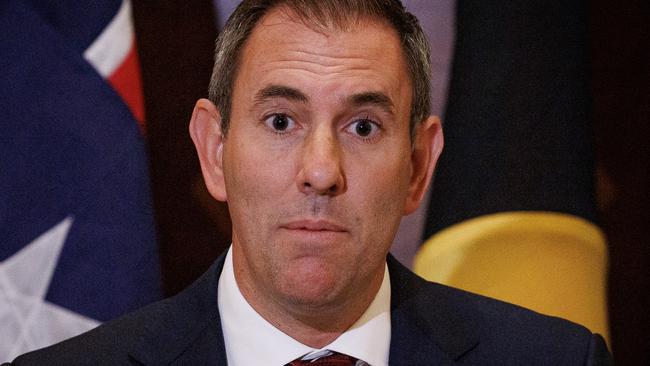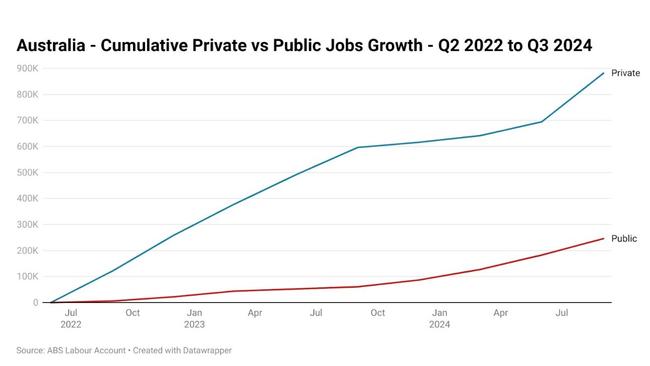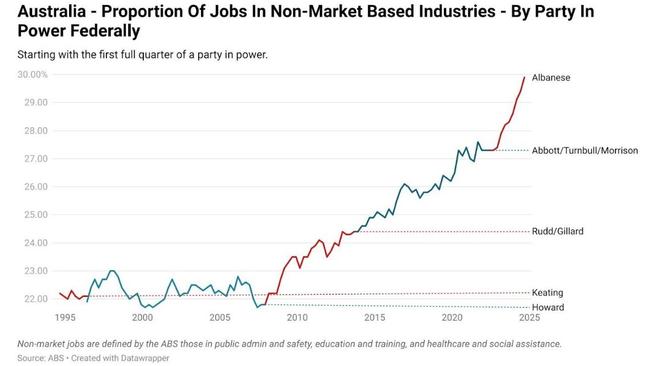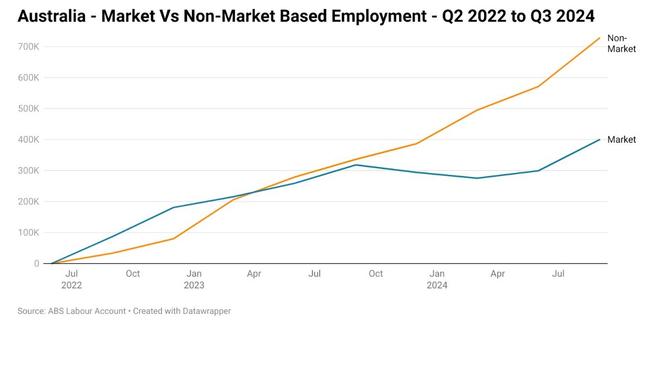‘Highly problematic’: Huge ‘risks’ lurking in Australian economy
A staggering new trend has emerged since the Albanese government came into power – and it could have a big impact on the economy.
Economy
Don't miss out on the headlines from Economy. Followed categories will be added to My News.
ANALYSIS
As the undeclared election campaign continues to be waged by the Albanese government and the Coalition, the issue of jobs and the labour market has emerged as a key battleground. Amid headlines of record levels of non-market jobs growth, Treasurer Jim Chalmers and other senior government figures have been out there in medialand attempting to make the case that Labor has done a good job with the nation’s labour market.
Non-market jobs are defined as those in the public administration and safety, education and training, and healthcare and social assistance. In effect, industries where employment is overwhelmingly government funded in some capacity in aggregate.
On the other side of the coin, market-based jobs are those in all other industries.
In a recent interview with ABC’s 7:30, Treasurer Chalmers attempted to place the focus on the split between public sector and private sector job creation during the government’s time in office.
“You’ll hear people make the distinction between market and non-market. A more helpful distinction is between the private sector and the public sector, and four in every five jobs which have been created under the life of this government have been private sector jobs,” Dr Chalmers said.

But is the distinction between private and public sector jobs more helpful, as the Treasurer suggests, or is the contrast between market and non-market-based jobs the one that provides a greater degree of clarity on how the labour market is faring?
In the interest of balance, we’ll be looking at both metrics, based on the same Australian Bureau of Statistics Labour Account figures cited as a source by the Treasurer.
The other side of the equation
While the Albanese government is placing the emphasis on the public versus private split in the labour market statistics as evidence of its credentials on the labour market, there are economists who view the market versus non-market metric as the more complete indicator.
With an increasingly large number of private companies being paid to provide services to the public on behalf of government, the expansion in the number of jobs that are funded by government coffers is not adequately captured by the public versus private split in employment statistics.

But there are also limitations on this metric which can cut both ways. On one hand, the overwhelming majority of the almost 200,000 workers currently employed for the construction of public infrastructure (from back end IT engineers to concrete mixer drivers) are considered as being in market-based employment.
On the other hand, individuals employed by private schools and private tertiary education institutions are counted as in non-market based jobs.
Public versus private
Between the end of the June quarter of 2022, which saw the Albanese government elected in May of that year, and the conclusion of the September quarter of 2024, total public sector employment rose by 246,000 jobs.
On the other side of the coin, private sector employment rose by 881,000 jobs.

Across that time period, 21.8 per cent of cumulative employment growth was in the public sector.
Shortly after the election of the Albanese government, 14.6 per cent of overall employment was in public sector roles.
To put this into perspective, in the five years prior to the pandemic, 9.7 per cent of cumulative jobs growth was in the public sector.
The relatively low level of public sector job growth prior to the pandemic ironically brings us back to the issue of the day, the utility of market versus non-market jobs as a labour market indicator.

Market versus non-market
If we go all the way back to Q3 1994, the beginning of the market versus non-market job split in the ABS Labour Account, two distinct eras emerge.
Prior to the global financial crisis under the leadership of the Keating and later Howard governments, the level of non-market employment as a proportion of the overall workforce remained remarkably stable, bouncing around in a limited range between 21.7 per cent and 23.0 per cent.
To put this figure into perspective, as of the latest data, 29.9 per cent of jobs are in non-market roles.

Since the 2008 Global Financial Crisis, employment growth has undergone a major shift, with non-market employment growth taking over as the driver of the majority of employment growth in aggregate.
In the years since the GFC, 51.2 per cent of employment growth has been in non-market roles.
Taking us back to the time period covered by the figures mentioned by Treasurer Chalmers, in the nine quarters of data that cover the Albanese government’s time in office, 64.5 per cent of the 1.12 million total jobs created have been in non-market roles.

Looking at a chart of the data, a clear trend is immediately apparent – the majority of market-based jobs growth seen since the Albanese government was elected had drawn to a close by the end of the first quarter of 2023.
Of the cumulative 399,700 market jobs added since the government was elected, 79.6 per cent had occurred by the end of the March quarter of 2023.
In terms of the last 12 months of data, 82.7 per cent of the 472,800 jobs created were in non-market roles.

A looming issue
While the expansion in non-market employment has played an instrumental role in creating jobs and putting downward pressure on unemployment, it’s a pathway that has limits and risks.
With almost three times more non-market jobs being created in the last 12 months than the pre-Covid five-year average, an attempt to revert to normal settings could see unemployment rise significantly if the economy is unable to rebalance to creating significantly more market based jobs.
But a continuation of the post-GFC status quo also has issues. Growth in the level of debt held by state governments is increasingly of concern in several state capitals, with the Queensland government raising the alarm in its recent budget update and Victoria cancelling the Commonwealth Games and selling off government assets.

When the GFC hit Australia’s shores in 2008, we had more scope by far to expand non-market employment than any other nation in the Anglosphere. Today, most of that scope is gone in relative terms, with Australia set to surpass the US for reliance on this type of employment if current trends continue, despite the US being in a completely different league less than a decade ago.
For now, the resources have been there to help pay for this expansion without putting too much pressure on growing government debt, but this is due in large part to luck delivering yet another commodity export driven windfall to government Treasuries.
But when more lean times come and challenging choices eventually need to be made, a continued high degree of reliance on non-market employment growth could be highly problematic for government coffers and the broader economy.
Tarric Brooker is a freelance journalist and social commentator | @AvidCommentator
Originally published as ‘Highly problematic’: Huge ‘risks’ lurking in Australian economy





